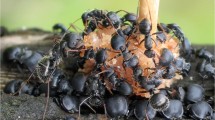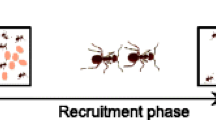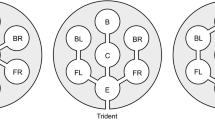Abstract
To gain additional territory while defending existing territory, animals must acquire and use information regarding resource characteristics and competitive pressure. For social organisms like ants, individual workers have experiences to acquire information, but territory establishment is a colony level behavior. Colony behavior, in turn, affects community structure. Here, I investigate how an individual ant’s previous experience affects its future foraging behavior and how individual behaviors can scale up to community territorial structure for two coexisting Formica species. To do this, I combine a field survey, a multi-agent computer simulation, and a manipulation experiment. The field survey shows that workers of both species co-occur on many trees early in the season, but ants on trees become segregated by species as the season progresses. The simulation demonstrates how this segregated spatial distribution can result from ants using a foraging strategy in which individuals show a preference for foraging sites based on previous experience. The experiment suggests that these ants are indeed capable of experience-based foraging behavior; ants preferentially return to sites where they have had positive experiences and avoid sites where they have had negative experiences. Results from this study suggest that spatially explicit information can be collected and stored by individuals to facilitate colony territorial structure, and that future investigations of community territory formation should include effects of individual previous experience.





Similar content being viewed by others
References
Adams ES (1990) Boundary disputes in the territorial ant Azteca trigona: Effects of asymmetries in colony size. Anim Behav 39:321–328
Adams ES (1994) Territory defense by the ant Azteca trigona: maintenance of an arboreal ant mosaic. Oecologia 97:202–208
Adams ES (1998) Territory size and shape in fire ants: a model based on neighborhood interactions. Ecology 79:1125–1134
Adler FR, Gordon DM (1992) Information collection and spread by networks of patrolling ants. The Am Nat 140:373–400
Adler FR, Gordon DM (2003) Optimization, conflict, and nonoverlapping foraging ranges in ants. The Am Nat 162:529–543
Agresti A (2002) Categorical data analysis (second edition). Wiley, New York
Camazine S, Deneubourg JL, Franks NR, Sneyd J, Theraulaz G, Bonabeau E (2001) Self-organization in biological systems. Princeton University Press, New Jersey
Cheney DL (1987) Interactions and relations between groups. In: Smuts BB, Cheney DL, Seyfarth RM, Wrangham RW, Struthsaker TT (eds) Primitive societies. University of Chicago Press, Chicago, pp 267–281
Cosens D, Toussaint N (1985) An experimental study of the foraging strategy of the wood ant Formica aquilonia. Anim Behav 33:541–552
Crawley MJ (2007) The R book. Wiley, West Sussex
Davidson DW (1998) Resource discovery versus resource domination in ants: a functional mechanism for breaking the trade-off. Ecol Entomol 32:484–490
DeAngelis DL, Mooij WM (2005) Individual-based modeling of ecological and evolutionary processes. Ann Rev Ecolog Evolutionary Syst 36:147–168
de Vries H, Biesmeijer JC (1998) Modeling collective foraging by means of individual behavior rules in honey-bees. Behav Ecolog Sociobiol 44:109–124
Dukas R (2008) Evolutionary Biology of Insect Learning. Ann Rev Entomol 53:145–160
Dussutour A, Deneubourg JL, Fourcassié V (2005) Amplification of individual preferences in a social context: the case of wall-following in ants. Proc Royal Soc B 272:705–714
Eason P, Hannon SJ (1994) New birds on the block: new neighbors increase defensive costs for territorial male willow ptarmigan. Behav Ecol Sociobiol 34:419–426
Fewell JH (1990) Directional fidelity as a foraging constraint in the western harvester ant, Pogonomyrmex occidentalis. Oecologia 82:45–51
Fourcassié V, Traniello JFA (1993) Effects of experience on food-searching behavior in the ant Formica schaufussi (Hymenoptera: Formicidae). J Insect Behav 6:287–299
Gilbert N, Troitzsch KG (2005) Simulation for the social scientist. Open University Press, Berkshire, England
Gillespie DT (1977) Exact stochastic simulation of coupled chemical reactions. The J Phys Chem 81:2340–2361
Giurfa M (2006) Associative learning: the instructive function of biogenic amines. Curr Biol 16:R892–R895
Gordon DM, Rosengren R, Sundstrom L (1992) The allocation of foragers in red wood ants. Ecol Entomol 17:114–120
Healy S, Braithwaite V (2000) Cognitive ecology: a field of substance. Trends Ecol Evol 15:22–26
Hölldobler B (1976) Recruitment behavior, home range orientation and territoriality in harvester ants, Pogonomyrmex. Behav Ecolog Sociobiol 1:3–44
Hölldobler B, Lumsden CJ (1980) Territorial strategies in ants. Science 210:732–739
Hölldobler B, Wilson EO (1990) The Ants. Belknap, Cambridge, Massachusetts
Keim P, Paige KM, Whitham TG, Lark KG (1989) Genetic analysis of an interspecific hybrid swarm of Populus: occurrence of unidirectional introgression. Genetics 123:557–565
Kendal RL, Coolen I, Laland KN (2004) The role of conformity in foraging when personal and social information conflict. Behav Ecol 15:269–277
Kokko H, Lopez-Sepulcre A, Morrell LJ (2006) From hawks and doves to self-consistent games of territorial behavior. The Am Nat 167:901–912
Mangel M (1993) Motivation, learning, and motivational learning. In: Papaj DR, Lewis C (eds) Insect learning. Chapman and Hall, New York, pp 158–173
McNamara JM, Green RF, Olsson O (2006) Bayes’ theorem and its applications in animal behaviour. Oikos 112:243–251
Meyer D, Zeileis A, Hornik K (2007) vcd: visualizing categorical data. R package version 1.0-4
Morrell LJ, Kokko H (2003) Adaptive strategies of territory formation. Behav Ecolog Sociobiol 54:385–395
Nicholson DJ, Judd SP, Cartwright BA, Collett TS (1999) Learning walks and landmark guidance in wood ants (Formica rufa). J Exp Biol 202:1831–1838
Pratt SC, Sumpter DJ, Mallon EB, Franks NR (2005) An agent-based model of collective nest choice by the ant Temnothorax albipennis. Anim Behav 70:1023–1036
R Development Core Team (2007) R: A language and environment for statistical computing. R Foundation for Statistical Computing. URL http://www.R-project.org
Rayor LS (2004) Social organization and space-use in Gunnison’s prairie dog. Behav Ecolog Sociobiol 22:69–78
Rice WR (1989) Analyzing tables of statistical tests. Evolution 43:223–225
Rosengren R, Fortelius W (1987) Trail communication and directional recruitment to food in red wood ants (Formica). Annales Zoologici Fennici 24:137–146
Rosengren R, Sundström L (1987) The foraging system of a red wood ant colony (Formica s. str.) - collecting and defending food through an extended phenotype. In: Pasteels JM, Deneubourg JL (eds) From individual to collective behavior in social insects. Birkhäuser Verlag, Boston, Massachusetts, pp 117–137
Saleh N, Chittka L (2006) The importance of experience in the interpretation of conspecific chemical signals. Behav Ecolog Sociobiol 61:215–220
Schilman PE, Roces F (2003) Assessment of nectar flow rate and memory for patch quality in the ant Camponotus rufipes. Anim Behav 66:687–693
Schoener TW (1983) Field experiments on interspecific competition. The Am Nat 122:240–285
Sommer S, von Beeren C, Wehner R (2008) Multiroute memories in desert ants. Proc Nat Acad Sci USA 105:317–322
Stamps JA, Krishnan VV (2001) How territorial animals compete for divisible space: a learning-based model with unequal competitors. The Am Nat 157:154–169
Sumpter DJ, Pratt SC (2003) A modeling framework for understanding social insect foraging. Behav Ecolog Sociobiol 53:131–144
Sundström L (1993) Foraging responses of Formica truncorum (Hymenoptera; Formcidae); exploiting stable vs. spatially and temporally variable resources. Insectes Sociaux 40:147–161
Tanner CJ (2006) Numerical assessment affects aggression and competitive ability: a team-fighting strategy for the ant Formica xerophila. Proc Royal Soc B 273:2737–2742
Tanner CJ (2008a) Resource characteristics and competition affect colony and individual foraging strategies of the wood ant Formica integroides. Ecolo Entomol 33:127–136
Tanner CJ (2008b) Aggressive group behavior in the ant Formica xerophila is coordinated by direct nestmate contact. Anim Behav 76:1335–1341
Vet LEM, Groenewold AW (1990) Semiochemicals and learning in parasitoids. J Chem Ecol 16:3119–3135
Wimp GM, Whitham TG (2001) Biodiversity consequences of predation and host plant hybridization on an aphid-ant mutualism. Ecology 82:440–452
Wright PJ, Bonser R, Chukwu UO (2000) The size-distance relationship in the wood ant Formica rufa. Ecol Entomol 25:226–233
Acknowledgements
I thank F. Adler for his support with computer simulations and manuscript revisions. Comments from K. Houck, S. Pratt, J. Seger, and two anonymous reviewers improved earlier versions of this manuscript. T. Whitham provided access to the field site. All experiments comply with the current laws of the country in which they were performed.
Author information
Authors and Affiliations
Corresponding author
Additional information
Communicated by J. Traniello.
Rights and permissions
About this article
Cite this article
Tanner, C.J. Individual experience-based foraging can generate community territorial structure for competing ant species. Behav Ecol Sociobiol 63, 591–603 (2009). https://doi.org/10.1007/s00265-008-0694-1
Received:
Revised:
Accepted:
Published:
Issue Date:
DOI: https://doi.org/10.1007/s00265-008-0694-1




